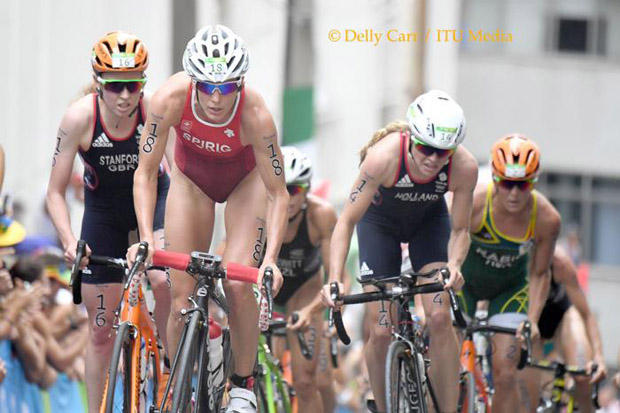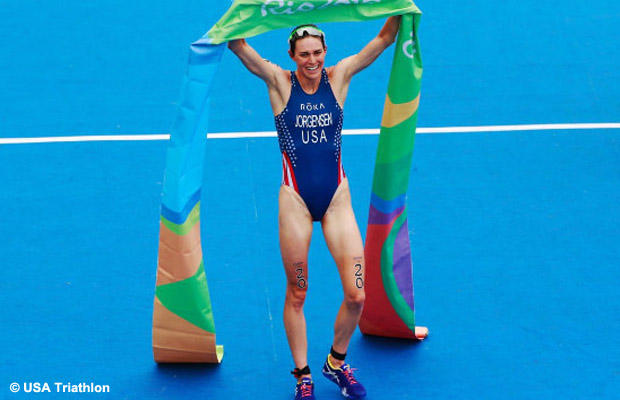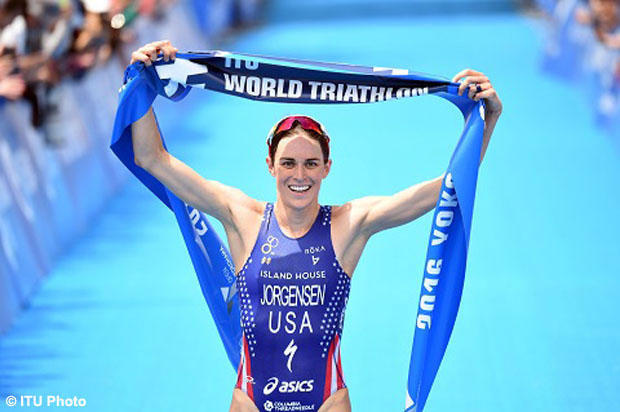What she was thinking
Outsiders gave her little chance to defend her 2012 Olympic gold medal. In the four years since London, Nicola Spirig had a baby and essentially went off the WTS map while Gwen Jorgensen became the most dominant woman in ITU Olympic distance history. Adapting to a broken hand in March, Spirig and coach Brett Sutton devised an unorthodox training regimen and a race strategy that turned an anticipated runaway into a race.
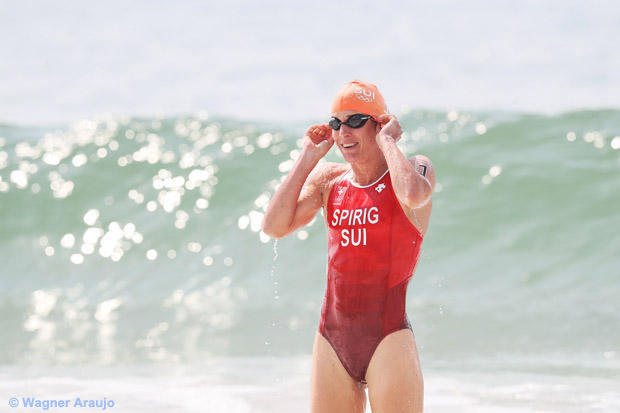
Slowtwitch: Because you had a long recovery after breaking your hand, were you surprised when you came out of the water in Rio tied with Gwen Jorgensen in 23rd place – just 11 seconds behind the swim leader Carolina Routier of Spain?
Nicola Spirig: After breaking my hand in March, we weren't sure how much it affected my swim. I worked very hard in the swim in the last months before the Olympics and we made some changes to the technique to make it suit the course in Rio and my personality. I started to feel good concerning my swim in the last two or three weeks, but as I hadn't done any WTS racing against the girls of the highest level I wasn't sure if I could swim in the first pack. I was pleased when I came out in the first pack but it was just the first step.
ST: What led you to have such a good position out of the water?
Nicola: Beach starts certainly suit me. I am good running to the water and handling the waves at the start. We were training for that, additionally to having changed my swim style the day after London so that it would suit swimming in the ocean with a lot of waves. So I was pleased to have choppy conditions and it certainly helped me. Changing the swim style also helped me losing less energy in the swim and saving more power on the bike, so I knew even not being 100% in the swim I would be better than in London.
Thanks to Brett, I also chose a start position on the right side. Not having the big fights that are common after a dive off the pontoon, I could swim my rhythm and had no problems to keep up with the first pack.
ST: Gwen Jorgensen’s teammate Sarah True said that the only way to beat her was to get a lead on her on the bike. Earlier this year, Flora Duffy, Helen Jenkins, Non Stanford and Katie Zaferes made breaks on Gwen. Did you expect to find partners to break away from Jorgensen?
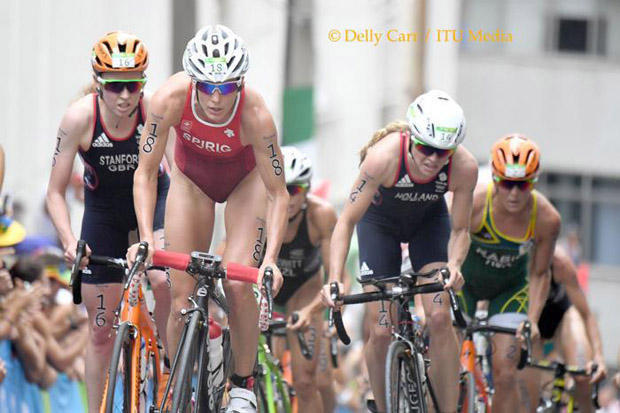
Nicola: Of course a break would have been the best race scenario. I had been talking to Flora Duffy before the race to see if we could try to break away together. In my eyes she is the most explosive one on the bike so she has the best chance to break away. But I am faster over 40km so I would have ridden her down if she would have broken away on her own. Both of us were not afraid to work hard on the bike. Therefore it would have been perfect to break away with her. We tried once, but it didn't work. I never saw her near the front again except the one time where I [made] a small break [30 meters] and she rode me down. A common sponsor said after the race that [Duffy] felt she didn't have the legs on race day. Helen [Jenkins] and Sarah [True] both also had problems on race day. I think the course was too technical for Katie Zaferes, and Non [Stanford] was not fast enough, so there was no one who could really help me initiate a breakaway. Each time someone other than myself was leading, the pace slowed several km/h. While a breakaway didn't happen, by accelerating out of every corner and keeping the pace high, I could still use my strength on the bike to make everyone tired. Triathlon is an individual sport, therefore I never rely on others and always make sure I can have an impact on the race on my own.
ST: Brett said you had a chance to make a solo break but the course made it impossible to execute.
Nicola: My mini break was happening at the wrong place of the course. It was not far from the hill, the one place where everyone was sprinting up. Additionally, it was the only time Flora Duffy made a move on the bike and rode me down. If the [other] athletes would have thought well, they of course should have let Gwen try to ride me down.
ST: Why didn’t you try to make a break on your own?
Nicola: I am not a fast sprinter with a lot of explosiveness, which makes it hard for me to break away on my own, especially keeping the pace high myself over the whole course. So, I didn't count on it. But of course I would have taken the chance if it had arisen.
ST: Did you try to make a break with anyone else?
Nicola: One time Barbara Riveros and I had a small gap after the hill. I wanted to see if we could break away after the downhill, but the second hill was too short to really make a difference.

ST: Do you think the rest of the top women were unable to accompany or unwilling to make a break with you?
Nicola: In my opinion, with Sarah, Helen and Flora having problems, there weren't many athletes who could have been a lot of help. Of course some of the athletes have the tactics to avoid the lead to save energy for the run. Absolutely legitimate. Maybe with Gwen in the race, not the right tactics to win.
ST: When Jorgensen took the lead for the front pack for a short time, what did that tell you?
Nicola: I think Gwen improved on the bike and showed a good performance. It didn't influence my racing much, I tried to use the fact that she was often riding behind me in the second part of the bike to ride the corners hard and create a small gap so that she had to [work to] close them. I didn't expect her to drop out of the pack, so if she rides at the back or among the first few doesn't change much for me.
ST: Do you feel your strong pace on the bike leg made Jorgensen expend energy that affected her on the run?
Nicola: I definitely think I reached my goal and made a lot of the athletes tired. You could see that on the run. The time differences between the top 10 athletes got very big because everyone was tired and struggling.
ST: Did your strong pace on the bike take some energy from your run?
Nicola: Yes, of course I used energy leading a big part of the bike leg. It would have been very interesting to run against Gwen when we both would have been sitting behind on the bike. But it was my choice to influence the race by creating a hard bike, and I think it was the right tactic. I think I was the fittest athlete standing on the start line, and I had trained for running on tired legs after a hard bike. I had also done three 70.3 races and some Swiss non drafting races to get used to it.

ST: When you and Jorgensen left the field behind and ran together for the first 8km of the run, were you surprised Jorgensen waited until the last lap of the run to make a break?
Nicola: She didn't wait. She made some attempts to break away before. I was surprised she let me lead after the first two laps, that is normally not her way. But I was basically prepared for all cases and just wanted to leave everything I had on that course that day and fight until the end.
ST: What did you and Jorgensen talk about on the third lap of the run when you zig-zagged and slowed down to get her to lead?
Nicola: I knew Gwen is a very strong athlete and when getting off the bike with the lead group she is unbeaten since at least three years I think. I was aware it would be very hard to beat her and I wanted to use everything I could to get her out of her rhythm. Every athlete can use her own tactics and no one is obliged to lead. But of course I tried to get her to lead in order to save energy and to make her a bit more tired. As mental games are not common in triathlon, I also tried to destabilize her and get her out of her rhythm. There was a headwind on one side of the course. After I ran in front in the tailwind I wanted her to lead in the headwind again as I was expecting her to attack afterwards and wanted to save my energy for the attack. She refused and I told her we should share the work. Gwen answered that she had led the first two laps. I responded that I had just done my share of the lead, too, and in the end I was the one who already had an Olympic gold medal, so she was the one who had to do the work to also win one.

ST: After all was said and done, how would you rate your own Olympic performances – 2012 versus 2016?
Nicola: I am proud of both performances. It's not easy to show 100% on one particular day in four years with a lot of expectations and pressure, and I succeeded in both Olympic races. I didn't have a great day in London 2012. To still win in that extremely close sprint was a great performance. In 2016 the conditions were completely different. Having the accident in March, being a mother and having obligations and expectations as an Olympic Champion certainly made the preparation very challenging. I also had to be prepared for a lot of different race scenarios. There were a lot more possibilities than in London.
ST: Were you a better athlete in London or Rio?
Nicola: I think I am a better athlete now than I was in London. I tried to challenge Gwen in any way I could and did my best in all three disciplines, so I am very happy with my performance in 2016 as well and proud to have won another medal with the circumstances.
ST: How proud are you of your 2016 silver medal?
Nicola: I am very proud. To me I clearly didn't lose gold but won silver. I think it’s always harder to defend a title than to win one, and my preparation was very challenging. I am proud of the way I raced as I really tried everything to defend my title. A lot of people told me afterwards that they really enjoyed the way I raced and how I influenced the race. Gwen showed a great performance and was stronger on the day, so she deserved to win.
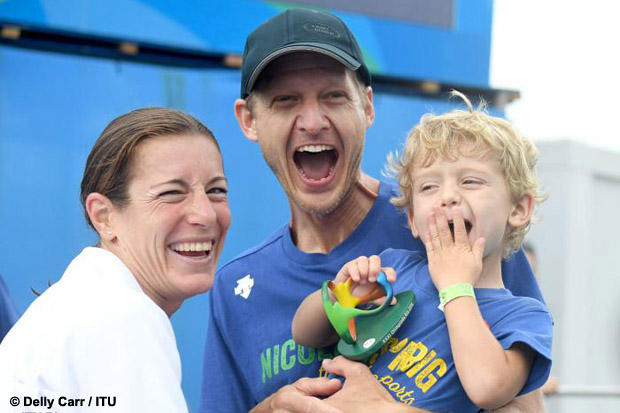
ST: What did you and Reto say to your child after the Olympics? Did you let him hold your medal?
Nicola: Yannis was with Reto watching the race (even if maybe spending more time playing at the beach right there and enjoying the Copacabana :)). I saw them straight after the award ceremony and it was probably the best moment, to share everything with the two persons who had supported me most and without their help I would long be retired. Of course Yannis can touch and hold the medal.


